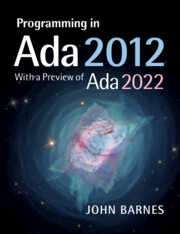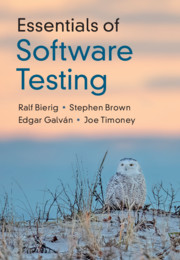Refine search
Actions for selected content:
5913 results in Programming Languages and Applied Logic
6 - Scalar Types
- from Part 2 - Algorithmic Aspects
-
- Book:
- Programming in Ada 2012 with a Preview of Ada 2022
- Published online:
- 05 May 2022
- Print publication:
- 19 May 2022, pp 73-100
-
- Chapter
- Export citation
Part 3 - The Big Picture
-
- Book:
- Programming in Ada 2012 with a Preview of Ada 2022
- Published online:
- 05 May 2022
- Print publication:
- 19 May 2022, pp 227-228
-
- Chapter
- Export citation
Program 2 - Sylvan Sorter
- from Part 2 - Algorithmic Aspects
-
- Book:
- Programming in Ada 2012 with a Preview of Ada 2022
- Published online:
- 05 May 2022
- Print publication:
- 19 May 2022, pp 223-226
-
- Chapter
- Export citation
Index
-
- Book:
- Programming in Ada 2012 with a Preview of Ada 2022
- Published online:
- 05 May 2022
- Print publication:
- 19 May 2022, pp 953-972
-
- Chapter
- Export citation
15 - Exceptions
- from Part 3 - The Big Picture
-
- Book:
- Programming in Ada 2012 with a Preview of Ada 2022
- Published online:
- 05 May 2022
- Print publication:
- 19 May 2022, pp 361-384
-
- Chapter
- Export citation
21 - Object Oriented Techniques
- from Part 3 - The Big Picture
-
- Book:
- Programming in Ada 2012 with a Preview of Ada 2022
- Published online:
- 05 May 2022
- Print publication:
- 19 May 2022, pp 551-586
-
- Chapter
- Export citation
Preface
-
- Book:
- Programming in Ada 2012 with a Preview of Ada 2022
- Published online:
- 05 May 2022
- Print publication:
- 19 May 2022, pp xvii-xx
-
- Chapter
- Export citation
16 - Contracts
- from Part 3 - The Big Picture
-
- Book:
- Programming in Ada 2012 with a Preview of Ada 2022
- Published online:
- 05 May 2022
- Print publication:
- 19 May 2022, pp 385-416
-
- Chapter
- Export citation
Contents
-
- Book:
- Programming in Ada 2012 with a Preview of Ada 2022
- Published online:
- 05 May 2022
- Print publication:
- 19 May 2022, pp vii-xiv
-
- Chapter
- Export citation
13 - Overall Structure
- from Part 3 - The Big Picture
-
- Book:
- Programming in Ada 2012 with a Preview of Ada 2022
- Published online:
- 05 May 2022
- Print publication:
- 19 May 2022, pp 263-296
-
- Chapter
- Export citation

Programming in Ada 2012 with a Preview of Ada 2022
-
- Published online:
- 05 May 2022
- Print publication:
- 19 May 2022

Essentials of Software Testing
-
- Published online:
- 19 August 2021
- Print publication:
- 19 August 2021
-
- Textbook
- Export citation
Frontmatter
-
- Book:
- Essentials of Software Testing
- Published online:
- 19 August 2021
- Print publication:
- 19 August 2021, pp i-iv
-
- Chapter
- Export citation
1 - Introduction to Software Testing
-
- Book:
- Essentials of Software Testing
- Published online:
- 19 August 2021
- Print publication:
- 19 August 2021, pp 1-26
-
- Chapter
- Export citation
12 - Random Testing
-
- Book:
- Essentials of Software Testing
- Published online:
- 19 August 2021
- Print publication:
- 19 August 2021, pp 259-277
-
- Chapter
- Export citation
2 - Equivalence Partitions
-
- Book:
- Essentials of Software Testing
- Published online:
- 19 August 2021
- Print publication:
- 19 August 2021, pp 27-47
-
- Chapter
- Export citation
9 - Testing Object-Oriented Software
-
- Book:
- Essentials of Software Testing
- Published online:
- 19 August 2021
- Print publication:
- 19 August 2021, pp 165-192
-
- Chapter
- Export citation
7 - All Paths Coverage
-
- Book:
- Essentials of Software Testing
- Published online:
- 19 August 2021
- Print publication:
- 19 August 2021, pp 113-140
-
- Chapter
- Export citation
Acknowledgements
-
- Book:
- Essentials of Software Testing
- Published online:
- 19 August 2021
- Print publication:
- 19 August 2021, pp xvii-xviii
-
- Chapter
- Export citation
Index
-
- Book:
- Essentials of Software Testing
- Published online:
- 19 August 2021
- Print publication:
- 19 August 2021, pp 303-304
-
- Chapter
- Export citation
